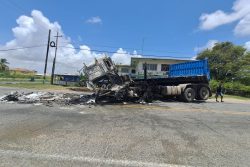Resolute action
 Between Earth Day 2016 and Earth Day 2017, 55 national instruments of ratification will have to be submitted to the Paris Agreement before it comes into operation. President Granger has indicated that Guyana’s instrument of ratification will be laid before the end of this year. By universal acclaim, the Paris Agreement is considered a workable global framework for resolute action to curb greenhouse gas emissions for halting global warming and climate change.
Between Earth Day 2016 and Earth Day 2017, 55 national instruments of ratification will have to be submitted to the Paris Agreement before it comes into operation. President Granger has indicated that Guyana’s instrument of ratification will be laid before the end of this year. By universal acclaim, the Paris Agreement is considered a workable global framework for resolute action to curb greenhouse gas emissions for halting global warming and climate change.
The Agreement requires each subscribing state to submit 1) pledges of reduction of greenhouse gases; 2) the performance targets and timetables for achieving these reductions; and 3) for rich countries to transfer at least US$100 billion annually by 2020 to poor countries to support their efforts. As previously indicated, Guyana has pledged to avoid deforestation and increase by 100 per cent its dependence on renewable energy.
At the Earth Day signing ceremony, the President publicly amplified on Guyana’s pledges. Guyana is offering to conserve 2 million hectares of forest for improved forest management; to reduce impact logging; and to ensure better governance of its rainforests. These commitments are contained in Guyana’s revised submission of its intended nationally determined contributions (INDCs) tendered under the Paris Agreement. Two concerns arise from this; firstly, the legal basis of the Paris Agreement comes into question, and, secondly, the evolution of Guyana’s global environmental commitments.
Is the Paris Agreement legally binding?
The consensus among international legal experts is that the Paris Agreement “walks a fine line legally”. On the one hand, nations are not legally bound to pre-determined levels/targets for cuts to their greenhouse gas emissions. Pledged cuts are left entirely to each nation. These are therefore non-binding in this sense. On the other hand, once cuts are pledged under the Agreement and performance targets set; national performances are regularly assessed against the targets on a legally binding basis!
Guyana environmental policy evolution
Nearly three decades ago, the then President Hoyte had made available to the global community some 3710km2 of Guyana’s forests for research. This research was to be directed at the methods/techniques for sustainable forest management and utilization of the multiple resources of the tropical forests and biodiversity conservation. This led to the later establishment of the Iwokrama International Centre for Rainforest Conservation and Development in 1996.
The Centre is an autonomous, non-profit body. Its Mission Statement declares that it: “seeks to promote the conservation and the sustainable use of tropical rainforests in a manner that leads to lasting ecological, economic, and social benefits to the people of Guyana and in general to the world by undertaking research, training, development, and dissemination of technologies”. Towards these ends it builds partnerships with local communities and the private business sector.
Historically, the Centre preceded the Low Carbon development Strategy (LCDS) modelled in the McKinsey Report of 2008, as adumbrated by Presidents Jagdeo, June 2009, and later President Ramotar in March 2013. The LCDS has indicated two main goals 1) “to transform Guyana’s economy to deliver greater economic and social development … by following a low carbon development path” and 2) “to provide a model for the world on how climate change can be addressed through low carbon development … if the international community takes the necessary collective actions, especially related to the United Nations Reduced Emissions from Deforestation and forest Degradation, REDD+, mechanisms”.
President Jagdeo’s document is presented for the 2009-2013 period under the rubric: ‘Starting the transition to a low carbon economy.’ President Ramotar’s is for 2013-2015 under the rubric: ‘The next stage in the low carbon transition.’
Starting with its 2015 Election Manifesto, the New coalition (APNU+AFC) government, has endeavoured to place Guyana’s environmental commitment at a higher level of ambition. This is now framed in the context of developing Guyana as a ‘Green Economy’. While this is clearly not the occasion or place to develop a long exegesis on the Green Economy, nevertheless, a few aspects of this, as can be gleaned from public documents, will be indicated for the rest of this column.
Green Economy
First, as the National Budget 2015, puts it, the Green Economy is anchored in Article 36 of the Constitution, which requires “that we sustainably extract our natural wealth for the benefit of current and future generations”. This is clear acknowledgement of the country’s inter-generational dependence on its natural resources, for which it is relatively well endowed.
Second, the cornerstone of all sustainable economic growth/development rests on the maintenance of macroeconomic stability. That is, what economists’ refer to as dynamic internal and external balance of domestic income, domestic expenditure, exports, imports, and overall investment flows, along with flexible enough prices including wage and interest rate to facilitate balances between supply and demand in markets.
Third, such an approach anticipates shocks and disruptions to economic processes. Thus from the very outset the need to establish a Sovereign Wealth Fund is acknowledged; particularly as Guyana approaches a time of oil and gas production
Fourth, and more specifically related to the subject under consideration here the Green Economy focuses on areas where the previous approaches have been more limited. To take a few examples; under the Green Economy the government is targeting the relatively neglected topic of reforestation in mined out parts of Regions 1, 7, and 9. Further, the LCDS had targeted almost exclusively hydropower, especially the Amaila Falls project, but as we saw under the Green Economy a wider mix of renewable energy projects are being actively considered: wind, solar, photovoltaic and biomass.
Also, while the LCDS had focused principally on the hinterland regions, the Green Economy directly targets the Coastal Zone and its management of greenhouse gas emissions. Finally, climate occurrences, (like the El Niño weather impacts which are different across Guyana’s regions) are not adequately targeted in the LCDS, but are concerns of great importance for the Green Economy.









